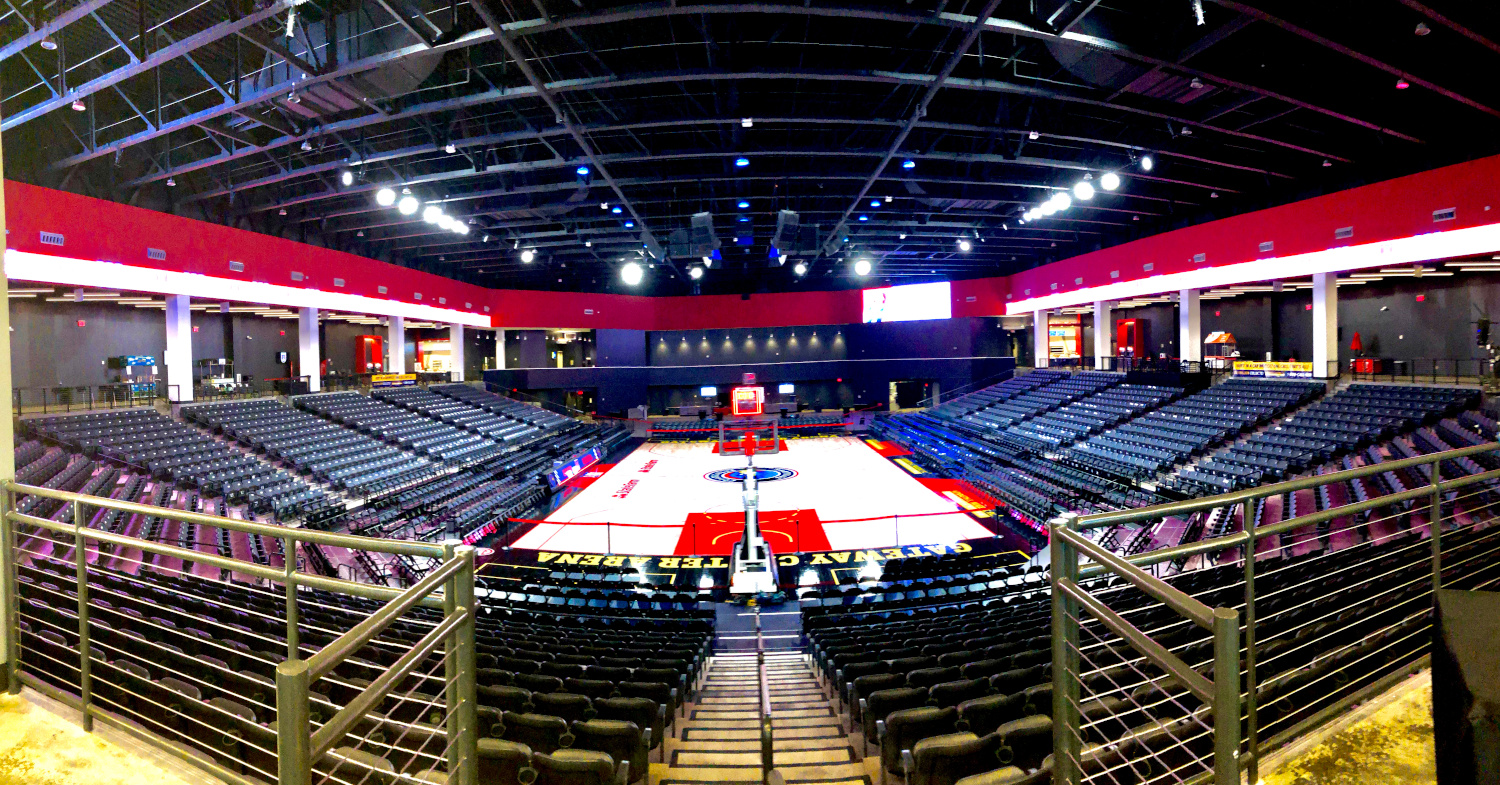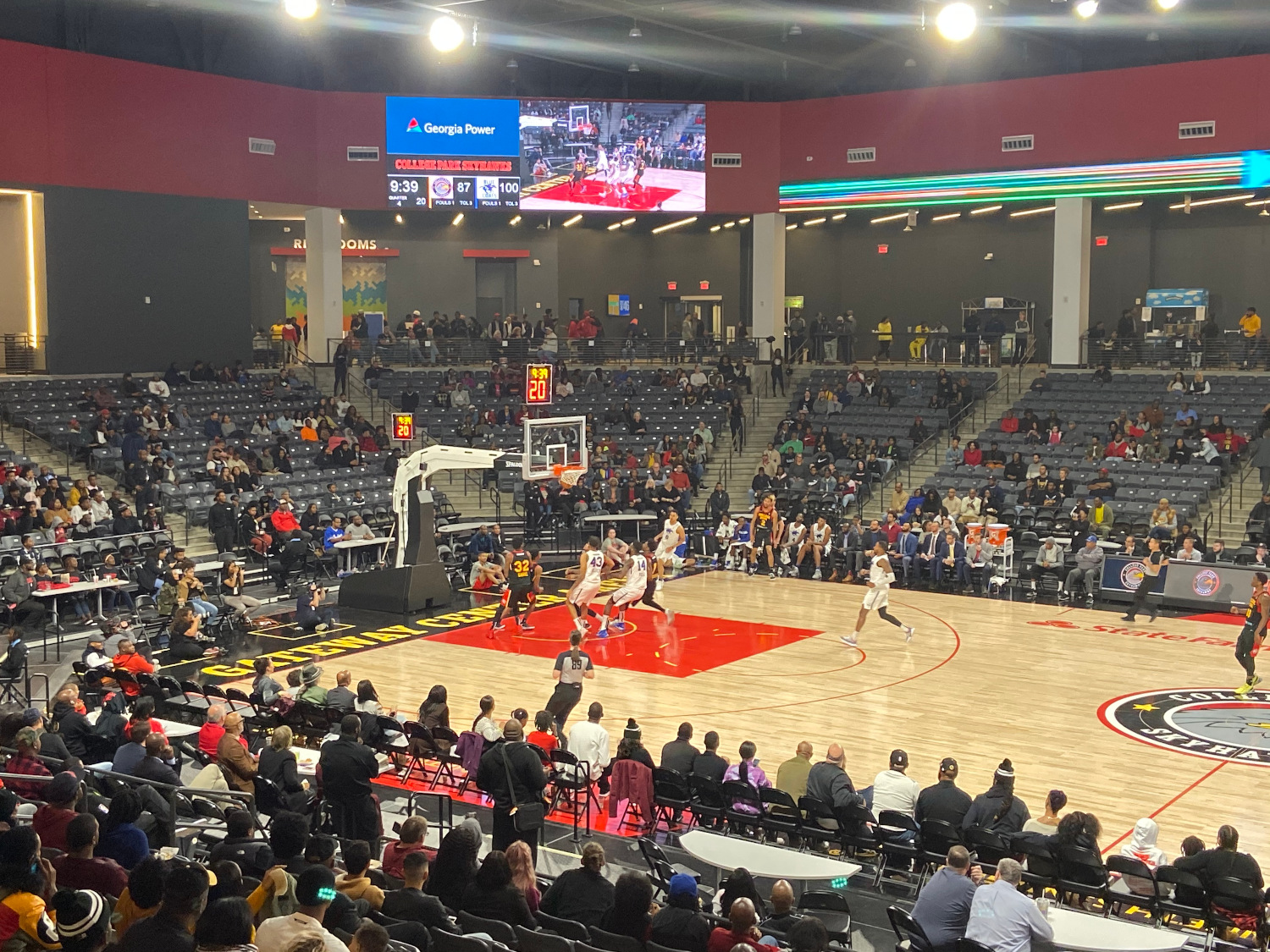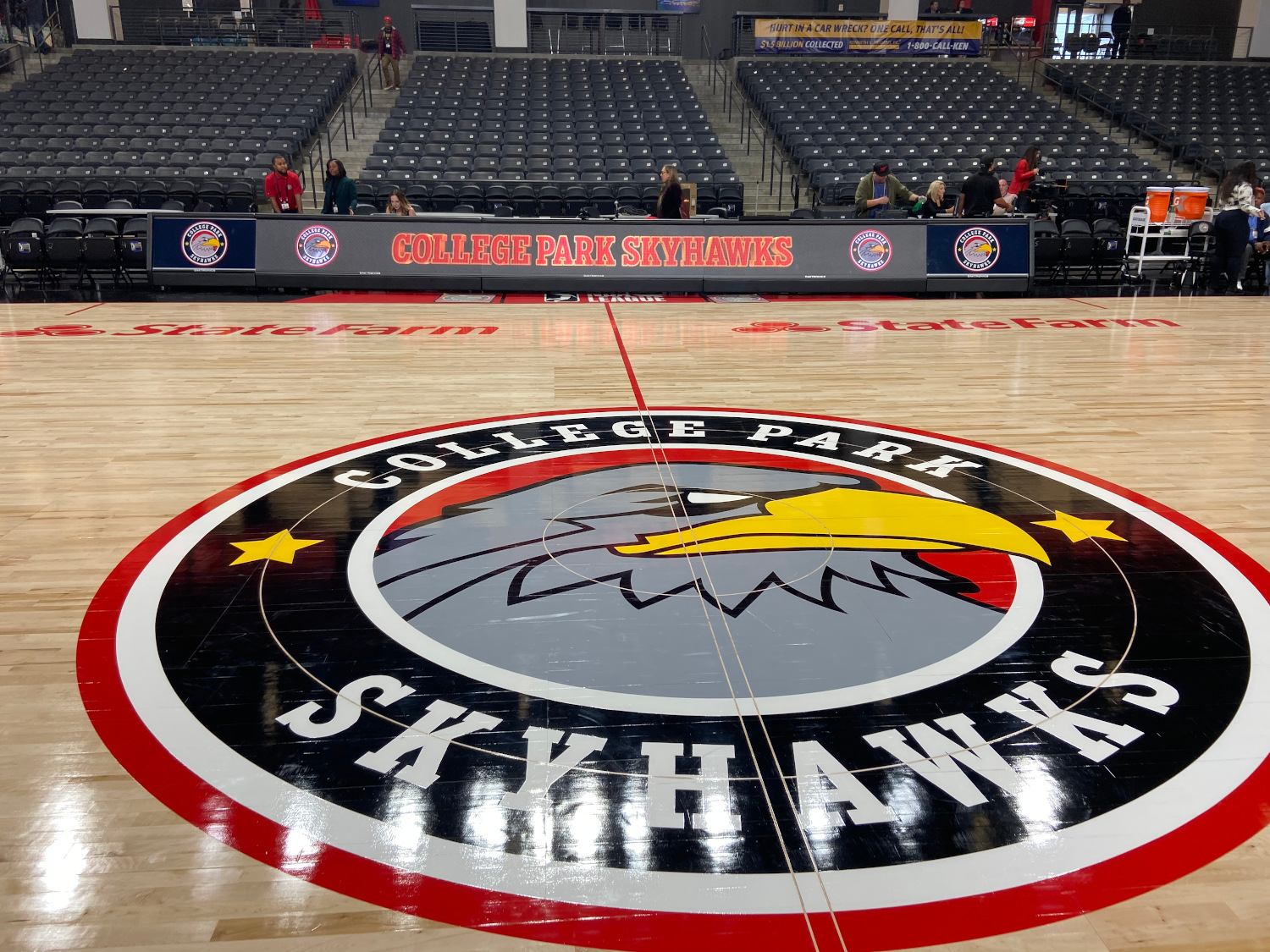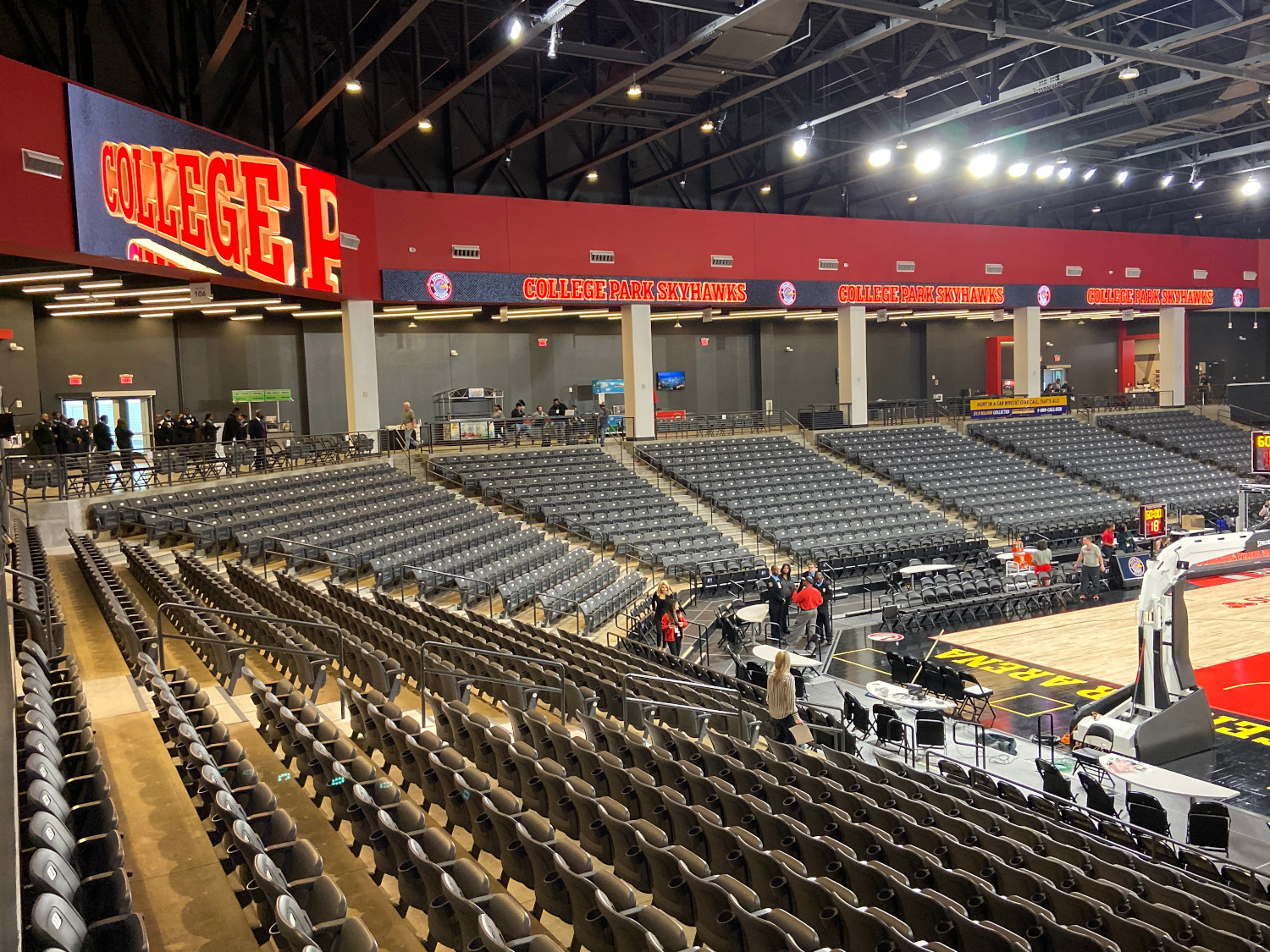New Atlanta-area minor-league arena reflects how smaller sports venues are meeting larger expectations with sound and video.
All eyes were on Atlanta GA and the massive Mercedes-Benz Stadium, home to the NFL’s Atlanta Falcons, when the twist-topped venue opened in 2017 and promptly served as the site of the 2018 Super Bowl. But eyes—and ears—are now on Atlanta’s newest sports venue, the 100,000-square-foot, 5,000-seat Gateway Center Arena, which opened its doors for the first time in October as the base for the National Basketball Association (NBA) Atlanta Hawks’ G-League team, the College Park Skyhawks, and the Women’s National Basketball Association’s (WNBA) Atlanta Dream.
There are a number of reasons for that. The $45 million Gateway Center Arena is a key cog in what has become a major raison d’être for almost all sports venues in recent years: to be foundation stones for urban—and, in more and more cases like this one, suburban—renewal and development. Here, it’s part of development that includes the second-largest convention center in the state, the Georgia International Convention Center (GICC), located in College Park GA, south of the downtown and with a direct rail link to Hartsfield Airport. (The venue is co-owned by both GICC and the town.) It joins a slate of new and old attractions and projects included in the Aerotropolis Atlanta Alliance’s redevelopment plans for the area.
In addition, at a time when all venues have to be multifunctional, the Gateway Center Arena comes with serious entertainment cred: booking and marketing for its concerts and family events are managed by The Fox Theatre, Atlanta’s signature midtown concert venue. Among the first shows was K-pop band AB6IX; in addition, esports team the Atlanta Faze hosted its first-ever Call of Duty League home stand at the arena.
Finally, with so much of the entertainment industry focused on on-demand access to content, the sporting world is a universal attraction for live entertainment. As a result, sports venues of any size or standing have to be able to provide visitors with a major-league experience. Thus, not surprisingly, the Gateway Center Arena made a significant investment in its audio and video systems.

“Sound plays an increasingly central part of the fan experience, from riling up the crowd to being detailed enough to convey important safety messages,” Rob Ligon, Senior MIS Manager at the GICC and the Gateway Center Arena, observed. “We wanted the sound system to be intelligent, and we achieved that by employing a vendor that listened to and exceeded our expectations.”
The Gateway Center Arena project was the kind that Tommy LaRue, National Systems Consultant at Stage Front, a leading regional AV integrator based in Savannah GA and with offices in Atlanta and Charleston SC, said are particularly desirable. “We did this as a design-build project, partnering directly with the architect, who initially brought us on to help develop the preliminary budgets for the arena’s AV,” he explained. “It wasn’t a typical or traditional bidding type of arrangement; instead, they asked us to bring our ideas to the table, to make sure that the systems that were specified could handle both sports and any other kinds of presentations or events the venue would need to host. They were asking for technical input but creative input, too. It’s not the way pro sports venues usually come together, but we’re used to working directly with the architects to be a design-build partner for the AV side of a project.”
James Brawley, Stage Front’s Principal Consultant, said the GICC’s technology consultant drew up some basic outlines of what the venue wanted to accomplish. These were intended as part of the organization’s original RFP but ultimately became a guideline for the types of systems and locations for their I/O points such as floor boxes.
After a need analysis was conducted, Ligon said the arena management’s team required a structured process of interviews, research and demonstrations to ensure that the final systems integrated seamlessly with its business model and operation. “Stage Front developed a formal program outlining the concept, functionality and budget of the desired system and they kept their word all the way to completion,” he said.

Close Coordination With Venue’s Techs
Ligon said the overarching challenge for the venue was its size. “It’s a mid-sized arena—we had to educate ourselves concerning what makes great sound in this type of venue, where there’s meant to be no bad seat in the house—both view and sound,” he explained. “Over 300 hours of studying sound engineering and power requirements was core to getting it right the first time.”
Sound for the entire venue was a major initial consideration, and implementation of the main-bowl PA system began as soon as the slabs and steel to support it were in place in March 2019. That being said, much of the time between then and the following October, when the venue opened officially, was spent interacting with other trades. For example, cabling was installed and routed for the AV infrastructure for the venue’s substantial concourse. LaRue notes that they worked with both the electrical contractor and GC on the location of wiring trays throughout the facility, much of which would support an extensive digital signage installation that provides services from menu boards at the concourse concessions to keeping their patrons up to speed on the game in the bowl.
“The locations for all of the audio and the video for signage had to be turned into construction drawings, so they could run the cabling and conduit to all of them,” Brawley said. “We also had a lot of input from the Skyhawks’ own tech people, which was very helpful. For instance, they told us where they’ve want the floorboxes, which were necessary for when the venue was used for other applications that sports, when a stage would be put in. That was one of the first things that had to happen. And we were also developing the equipment and procurement lists, loudspeaker choices and other things. It was a busy time with things other than just hanging speakers.”
In fact, LaRue added, the period was one that offered the integrator additional prospects for engagement with the project, expanding its work on the venue’s broadcast infrastructure. “We saw an opportunity to [increase involvement with] more of the project with things like the truck dock and tie lines to the control room, as well as coordinating with the Skyhawks’ technical staff on infrastructure decisions like the types of fiber and co-ax needed and their locations,” he said.
Building a sports arena today also means accommodating networked systems. In fact, one of the most frequent causes of change orders was the number and locations of IT drops, which affected the AV integrator, the venue’s IT staff and the electrical trades on the project. A solution was to schedule weekly meetings across the affected parties, including security and voice/data divisions, and managed by the IT coordinator. “Sometimes it would create as many problems as it solved,” Brawley joked, “but overall it was very good thing to do and had a lot of positive results, such as coordinating the rack space in the IT and control rooms, and coordinating with Daktronics’ people, who were putting in the two large scoreboard displays. Everyone needed sufficient space in the racks, and we had to work together to achieve that.”

A Real NBA-Like Experience
The decisions around the bowl PA system focused on the multifunctional aspect of the venue, which would range from basketball games (whose seating configuration holds 3,500), to music concerts (which seat up to 5,000), to local high-school graduations and other events, but also had to keep the budget in mind. But perhaps most important was the need to be able to provide an authentic NBA-type experience for fans. Brawley and LaRue decided on Bose’s relatively new ArenaMatch system, which would keep them within budget. The system’s steerability would also keep the sound on the seats and off the metal-sided interior, which would reduce the need for costly spray-on acoustical treatment over a large space. And Brawley determined that four two-box clusters of subwoofers, configured in an end-fire array, would provide sufficient low-end punch needed for what fans have come to expect from an NBA-level game.
The ArenaMatch’s DeltaQ array technology allows directivity—or “Q”—to vary in each module to match coverage precisely to audience area. Stage Front had nine coverage patterns to choose from, with 10°, 20° or 40° vertical coverage and between 60°, 80° or 100° horizontal waveguides to adjust horizontal coverage and create asymmetrical patterns where needed. Those characteristics also helped improve sight lines, reduced the array weights and lowered overall system costs. The system in the Gateway Center Arena consists of six clusters of four speakers each, facing the corners and the two long sides of the court seating, suspended from a ringed truss over the perimeter of the court; the two sub clusters are inside the corral formed by the line arrays. Two additional ArenaMatch boxes are suspended and downfiring as the center-court fill. Brawley said that, once the aiming of the system was done, using Bose’s Modeler software, the installation itself was relatively easy. “As easy as putting 350lb. boxes 40 feet off the floor can be,” he quipped.
The ArenaMatch system extended out to the concourse, much of which is open to the bowl, but which is used for sports-related events, such as dance squads. These areas have their own loudspeakers and subs, also downfiring from ceiling trusses. Bose MSA12X steerable arrays are also installed in the venue’s entrance lobby.
“The low-frequency energy and the volume have to be everywhere for the NBA experience,” LaRue said. He noted that the venue expressed its satisfaction with the ArenaMatch’s sound quality while he appreciated Bose’s technical support before and after installation, but the system also needs a lot of intelligibility, for announcements. “So we placed speakers close to areas like that to get both impact and clarity.” The concourse areas also use Community D8 and C6 ceiling speakers and D10 ceiling subs to extend distributed high-impact audio throughout those areas and other back-of-house areas, including lounges and restaurants, managed by QSC Q-SYS DSP. The ubiquitous IT and Dante-network drops placed throughout the venue came in handy for things like putting mobile DJs anywhere in the arena they’re wanted, he said. “There are a lot of sound sources in here, but we made sure the sound goes where it’s needed and stays there, which helps keep the sound quality high.” Brawley adds, “It takes a lot to make an NBA crowd happy with the sound, and everyone’s been very happy with this system.”

Keeping Score
Gateway Center Arena visitors will get a broadcast-quality video experience from the venue from a pair of 11.5’x34.5′ (HxW) Daktronics 5.9mm displays, located on opposite corners of the bowl. They’re joined by two ribbon boards, which are also 5.9mm resolution, that run 159’2″x3’3″ (LxH) around the room. The resolution values are in line with what fans would encounter with typical NBA center-hung scoreboards, according to Glen Marts, Southeast Regional Sales Rep for Daktronics, which also installed the venue’s courtside 28’x2′ (LxH) 6mm-pitch scorer’s table. In addition, Daktronics provided and installed the game clock and the shot clocks located above the backboards at either end of the court. (The shot clocks provide timing to the tenth of a second, a feature available only to NBA teams and their associated leagues.)
Content comes to the displays through Daktronics’ own show-control content-management system, with primary and backup using DMP-8000 series media players, installed and integrated by Daktronics and connected within to the venue’s video control room via networked fiber tie lines from the control system rack out to the LED displays.
“We worked with Stage Front on the tie lines, because our screens are showing [live] video from the cameras they installed, while some of the prerecorded content that goes directly to the displays also has audio [embedded], which has to be routed to the PA system,” Marts explained. “Also, the corner screens are being used for a lot of applications in addition to the video, such as the scores and stats and for sponsors, so they have to be windowed in a lot of different ways during an event. That’s done through our show-control software from the control room.”
Beyond the scoreboards, video is nearly as widely distributed throughout the concourse and other back-of-house areas as the audio is. LaRue estimated they installed more than 50 flatpanels of various sizes as monitors and for digital-signage applications. These pull content from a combination of sources over an IPTV system that can push up to six discrete channels throughout the venue, such as an Apple TV player tuned to the WNBA channel, running a total of 52 BrightSign players, as well as five HD tuners and two HD encoders from Contemporary Research.
The Gateway Center Arena’s control room is fairly sparse, mainly functioning as a matrix for routing AV signals around the facility. It’s not a production facility, per se, Brawley said, although there is cabling infrastructure for streaming to a NewTek TriCaster, which is used to get video from the bowl cameras to the scoreboards and, at times, out through local UHF station Peachtree TV.
“It’s not a huge arena, but it’s a place that shows how the technology is trickling down from the major-league venues to minor leagues and colleges, where the fans have come to expect the same experiences they get at the larger venues,” Brawley pointed out. “The digital signage, the distributed audio, the subs, the big scoreboards, the big PA systems…these are now standard design goals, from high school on up to the professional level. It’s not just about the game anymore—it’s about the gameday experience.”
For more installation features from Sound & Communications, click here.